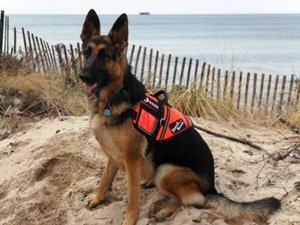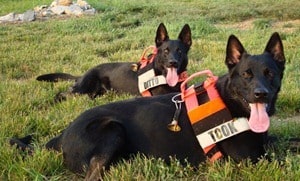Have you ever wondered if your dog has what it takes to be a search and rescue (SAR) dog? The skills of these heroic animals are called into play with every disaster imaginable: fire, tornado, flood, bombings, train wreck, plane crash, avalanche, earthquake, as well as searching for the young or elderly who may have wandered off.
SAR dogs detect human scent. With noses 10,000 times more powerful than ours, dogs follow microscopic particles, perspiration, and decomposition gasses left behind by humans. They do this in two ways: through airscenting or trailing.

Trailing dogs, by contrast, follow a specific scent, such as from a missing person’s hat or shirt. Trailing dogs not only follow scent, but also look for changes in terrain such as overturned earth or crushed vegetation. While airscenting dogs are brought to areas where rescuers feel it’s likely a missing person may be located, trailing dogs begin their search at the last known location of the missing person.
A SAR is Born
SAR dogs often specialize, such as in water or avalanche detection, or even in human remains detection (HRD). Not every dog is cut out for search and rescue work, although some breeds are better adapted than others. Bloodhounds, for example, are the quintessential trailing dogs, able to follow trails that are weeks old. Given the amount of physical exertion involved, SAR dogs are typically larger breeds, with German Sheppard’s, Newfoundland’s, Golden Retrievers, Labradors, Border Collies, Dobermans, Australian Cattle Dogs, and Giant Schnauzers leading the list.
More important than breed though, is attitude. Dogs must be obedient with high energy. A dog that can’t get enough of playing “fetch,” is a potential SAR candidate. SAR dogs are strongly reward motivated and will work non-stop to earn a toy. They are comfortable with crowds, loud noises, other animals, and will ignore distracting scents when on the job.
Dogs (and handlers) must be in peak physical condition, ready to work at a moment’s notice day or night. No couch potatoes need apply for SAR work. Dogs (and handlers) must be in peak physical condition, ready to work at a moment’s notice day or night. Dogs will be asked to explore dangerous nooks and crannies. SAR dogs showno fear of heights and can jump, run, balance, and find sure footing in debris such as glass or rotting logs.
Successful SAR dogs don’t consider the hours of training or search work as “work.” To them, it’s all a game and they’re eager to prove what they can do.
Non-Stop Training

Training begins young, at 8-10 weeks. A decision on whether a dog is well suited for search and rescue is made around nine months of age. On average, SAR dogs work 4-7 years.
Training sessions are frequent. Puppies might engage in obedience and socialization training several times a day, and scent train 3-7 times per week. Older SAR dogs might participate in a 4-8 hour search session once a week, with smaller task-oriented sessions spread throughout the week.
Search and Rescue Dogs
SAR dogs perform daily acts of heroism. The commitment to train and raise a SAR dog is immense, but the rewards to dog, handler, and community are rich. Many persons and their heartsick families owe their reunions to the work of a SAR dog. A dog who, without hesitation, responds with eager anticipation to his handler’s command of “Go find.”
